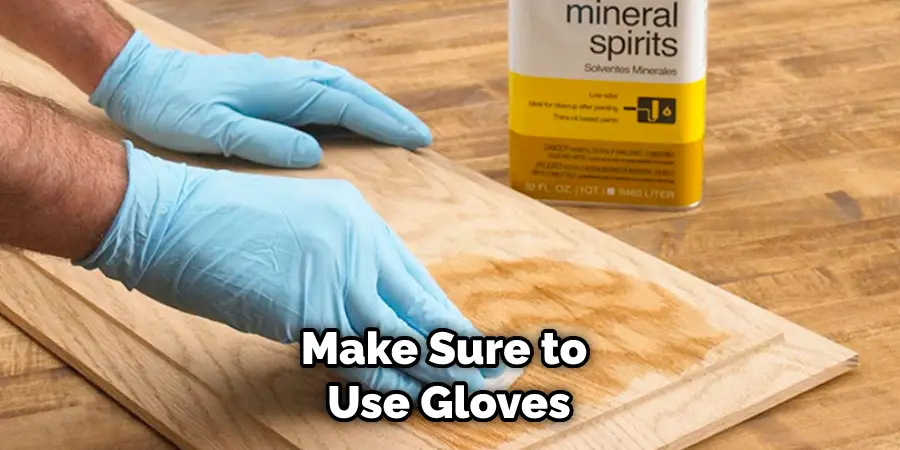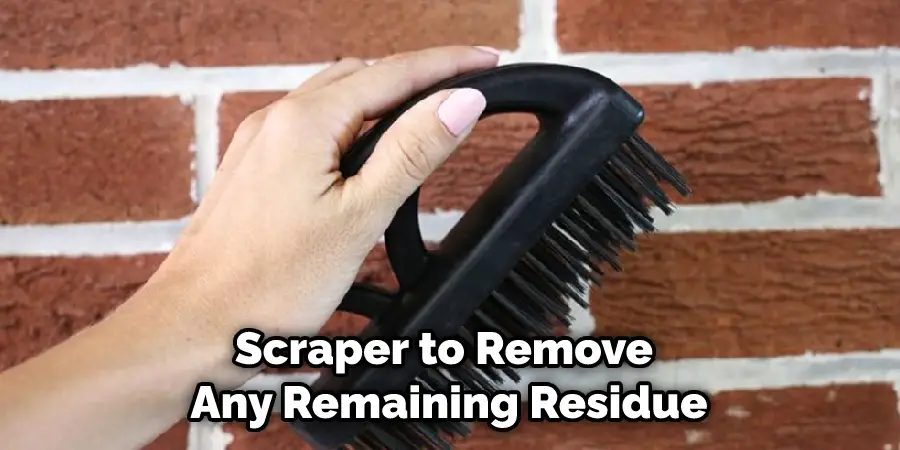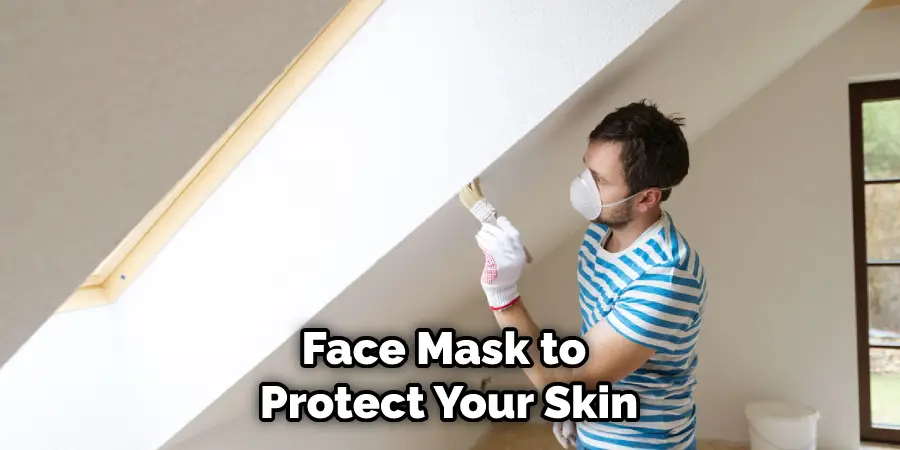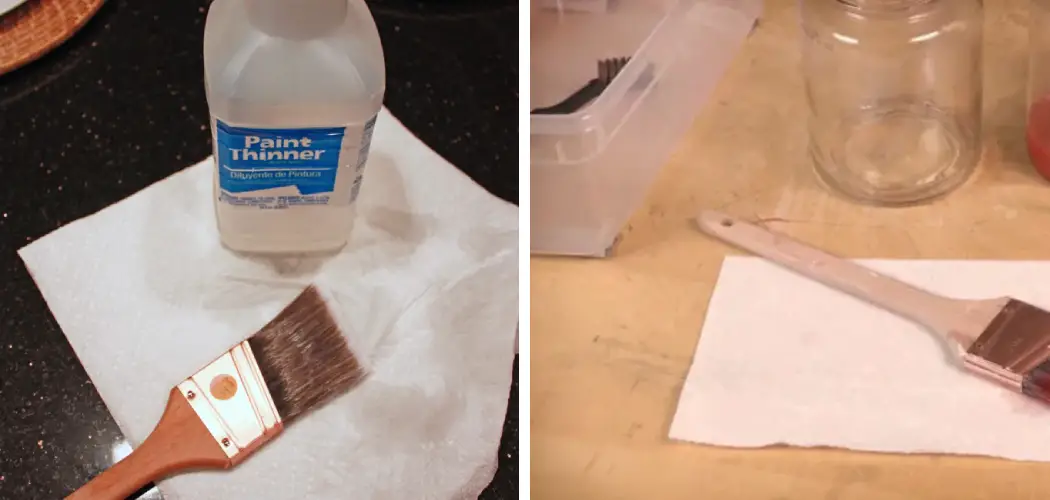Mineral spirits are a type of solvent used to thin and remove oil-based paints, varnishes, polyurethane, and stains. It can be found in many home improvement stores and effectively removes paint from surfaces such as wood trim or furniture.

When using mineral spirits to remove paint, it’s important to take a few steps to ensure the process is done safely and correctly. First, make sure you’re wearing safety gear such as gloves and goggles.
The main advantage of using mineral spirits to remove paint is that it is an effective and inexpensive method. Mineral spirits are available at most hardware stores, which makes them easy to access. Additionally, they are safe for use on most surfaces and can be used both indoors and outdoors.
Mineral spirits are also gentle enough not to cause any damage to the material that was coated with paint. They are also non-flammable and biodegradable, making them a safe option for removing paint. In this blog post, You will learn in detail how to use mineral spirits to remove paint.
Step-by-Step Processes for How to Use Mineral Spirits to Remove Paint
Step 1: Inspect the Painted Surface

Before you start removing paint with mineral spirits, take a look at the surface and check if it is suitable for this method. You should ensure the surface is not too delicate or fragile to work on. Always use mineral spirits in a well-ventilated area—ideally outdoors for safety reasons. Make sure to use gloves and protective clothing when working with mineral spirits.
Step 2: Test the Mineral Spirits
Before applying it on the painted surface, test a small area of the surface by rubbing a cloth soaked in mineral spirits onto it. This way, you can assess how well it works on that particular paint and adjust accordingly. Use a clean rag or cloth and gently rub it onto the surface, covering the paint completely. Continue rubbing until you see that it has softened and is becoming faint.
Step 3: Scrape Off Softened Paint
When enough of the paint has been dissolved, take a putty knife or scraper and try to scrape off the paint. While doing this, be careful not to damage the surface underneath. Wipe away any residue of softened paint from the scraped surface using a clean cloth.
Step 4: Rinse With Water
If any smudges of paint remain, rinse the surface with water. Make sure to use gentle pressure and not to rub too hard on delicate surfaces. Once you have removed all of the paint, let the surface dry completely. Depending on your preference and the type of surface, you can either re-paint or seal it with a sealant to protect it from further damage.

Step 5: Dispose of Mineral Spirits Properly
After you’re done using the mineral spirits, make sure to dispose of them properly. Never pour it into a drain or regular garbage can; instead, take it to a recycling or hazardous waste facility. By following these steps for Using Mineral Spirits to Remove Paint, you can ensure that you get the best results with minimal damage to the surface.
Safety Tips for How to Use Mineral Spirits to Remove Paint
- Always wear rubber gloves and safety goggles when using mineral spirits to remove paint.
- Ensure the room is well-ventilated; use a fan, or open a window to help with the airflow.
- Never leave an open container of mineral spirits unattended in your work area.
- Clean up any spills immediately with a damp cloth and throw away any soaked rags.
- Avoid inhaling the fumes – use a respirator or fan to help direct air away from your face.
- Never pour mineral spirits directly on the paint; instead, apply it to a cloth and then use it to wipe the paint off in small sections.
- Work in a well-lit area and use a flashlight to verify if all of the paint has been removed before moving on to the next section.
- Dispose of any mineral spirits and rags responsibly – never put them into the trash; instead, take them to your local hazardous waste disposal center or contact your local waste management authorities.

Using mineral spirits to remove paint is a common and effective technique, but it requires special attention to safety measures to prevent accidents or health concerns. Remember that all materials used should be handled properly and with caution.
How Do You Safely Use and Store Mineral Spirits?
When using mineral spirits to remove paint, it is important to take safety precautions. Wearing protective gloves when handling the product is always a good idea, and ensuring your workspace is well-ventilated. While mineral spirits produce fewer fumes than other solvents, they still emit hazardous vapors and should not be used in enclosed spaces.
Additionally, mineral spirits are flammable, so they should be kept away from open flames and heat sources. You should also make sure to store the product in its original container or a labeled safety can in a cool, dry place away from any children or pets.
Finally, when using mineral spirits, you want to ensure that you use them correctly and not over-applying. Too many mineral spirits can cause damage to the surface you are trying to clean and create a hazardous situation. Disposing of any used mineral spirits properly is also important by checking your local regulations for proper disposal instructions.
How Long Does It Take for Mineral Spirits to Work on Paint?
The amount of time it takes mineral spirits to remove paint will depend on the paint type and thickness. Oil-based paints typically take longer to remove than latex paints, as they are harder and more durable. You should usually give the mineral spirits at least 30 minutes to work on a painted surface. If the paint is still not coming off, you can allow the mineral spirits to sit for a bit longer.

However, be sure to check on it frequently so that it does not dry out or evaporate. After allowing the mineral spirits to work on the paint, use a brush or scraper to remove any remaining residue. Be careful when doing this, as mineral spirits can soften the surface of some materials. Always test a small area first to ensure that it will not damage or discolor the material.
If done properly and cautiously, you should have no problem using mineral spirits to remove paint from various surfaces.
How Should You Store Leftover or Unused Mineral Spirits?
When you are finished using mineral spirits to remove paint, it is important that you properly store any leftover or unused material. Ensure the container lid is securely tightened and place it in a cool, dry location away from sources of heat or open flames.
Store containers in an area with good ventilation if possible because mineral spirits can give off strong odors. Store the container in an area that is inaccessible to children and pets, as mineral spirits can be hazardous if ingested.
Additionally, dispose of any leftover or unused mineral spirits at your local hazardous waste facility to ensure proper disposal. When using mineral spirits, make sure you are wearing protective gear such as safety goggles and gloves in order to avoid contact with the skin.
Additionally, open windows and doors in your work area before use to ensure proper ventilation while using mineral spirits. Following these steps will help ensure the safe use of mineral spirits to remove paint from surfaces. By properly storing leftover or unused material and following safety precautions, you can effectively and safely use mineral spirits to remove paint.
How Can You Prevent Dust and Dirt From Getting Into the Mineral Spirits While You’re Using It?
When using mineral spirits to remove paint, it’s important to ensure that dirt and dust don’t get into the product. To prevent this, mask off the area with plastic sheeting or newspaper before starting your project. Additionally, use a damp cloth to wipe away debris from nearby surfaces. Wear protective gloves and a face mask to protect your skin and lungs from being exposed to fumes.

Finally, use an indoor space with good ventilation or set up a fan near your workspace to help dispel any vapors that may linger in the air. Following these tips can help you safely and effectively remove paint with mineral spirits. By following these steps, you can help ensure that you use mineral spirits safely and correctly so that all the paint is removed without any unwanted dirt or dust getting into the product.
How Do You Know if the Paint Has Been Completely Removed After Using Mineral Spirits?
After using mineral spirits to remove paint, you may need to evaluate if the job is done or if more work needs to be done. How can you tell? Here are some things to check for:
- Visually inspect the area for any remaining paint. If there are still traces of paint, then more mineral spirits must be applied to remove them.
- Feel the surface of the area. If you can still feel the paint on the surface, then try using a medium-grade steel wool and mineral spirits to remove any remaining traces before sanding.
- Look for any residual color left behind after removing the paint. If there are still streaks or discoloration, then use a clean rag and more mineral spirits to remove them.
- Make sure the surface is completely dry before painting over it. If not, you may need to wait for the area to dry thoroughly before beginning your project.
By completing these steps, you can easily tell if the paint has been successfully removed after using mineral spirits.
How Can You Be Sure That All of the Mineral Spirits Have Evaporated From a Surface Again?
When you have finished using mineral spirits to remove paint from a surface, it is important to ensure that all traces of the solvent have been removed prior to applying new paint. If not properly removed, mineral spirits can cause serious issues with the adhesion and durability of the new coat of paint.
The best way to be sure that all of the mineral spirits have been removed is to use a rag dampened with fresh water to wipe down the entire surface where the paint was removed.
Wipe the surface in one direction only, as this will ensure that all of the mineral spirits are completely wiped away. Then, allow the area to dry completely before beginning any painting activities. Sometimes, it is also wise to use a chemical test kit on the surface to check for residual mineral spirits. This will provide an extra assurance that no traces remain before painting.
If any substances are detected in the test, wipe down the area with a fresh rag dampened with water until the results come back clean. Once all of the mineral spirits have been removed, the surface is ready to be painted.

These tips and tricks will help ensure you get the best possible results when using mineral spirits for your painting projects. By taking the time to properly clean the surface before applying a new coat of paint, you can rest assured that your job will turn out looking great.
Conclusion
In conclusion, mineral spirits are a powerful and effective way to remove paint. They are versatile, easy to use, and can be used for many different surfaces. For best results, always ensure that the area you are working on is well-ventilated and that you wear protective gear such as gloves, goggles, and a respirator when using them.
With proper preparation, use, and disposal of the mineral spirits, you can effectively remove paint without causing any damage to your surfaces. I hope this article has been beneficial in learning how to use mineral spirits to remove paint. Make Sure the precautionary measures are followed chronologically.
About
Angela is the chief editor of Indoorense. She began her career as an interior designer before applying her strategic and creative passion to lifestyle and home.
She has close to 15 years of experience in creative writing and online content strategy for housekeeping and cleaning,home decorations as well as other efforts.
She loves her job and has the privilege of working with an extraordinary team. She lives with her husband, two sons, and daughter in Petersburg. When she’s not busy working she spent time with her family.

